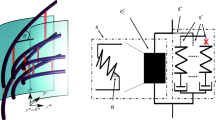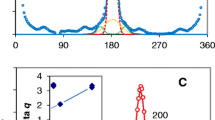Summary
A new model of rotating fibre components (helicoidal model) is proposed to explain the architecture of some plant cell walls. On the basis of tilting observations under the electron microscope, we establish the validity of this model for the cell wall ofChara vulgaris oospores. We suggest that this model explains the architecture seen in a number of published micrographs from a variety of different plant cell walls. Helicoidal architecture is shown to be distinct from the previously established crossed polylamellate architecture. The diagnostic features of helicoidal architecture are given. Morphogenesis of plant cell walls is discussed, with particular reference to self assembly in cholesteric liquid crystals.
Similar content being viewed by others
References
Albersheim, P., 1975: The walls of growing plant cells. Scient. Amer.232, 4, 80–95.
Altner, H., 1975: The microfiber texture in a specialized plastic cuticle area within a sensillum field on the cockroach maxillary palp as revealed by freeze fracturing. Cell Tiss. Res.165, 79–88.
Baynes, S. M., 1972: Light and electron microscope studies on the germination ofChara oospores. B. Sc. Thesis project, Bristol University.
Bouligand, Y., 1965: Sur une architecture torsadée répandue dans de nombreuses cuticules d'arthropodes. C. R. Acad. Sci (Paris)261, 3665–3668.
Chafe, S. C., 1970: The fine structure of the collenchyma cell wall. Planta90, 12–21.
—, 1974: Cell wall structure in the xylem parenchyma ofCryptomeria. Protoplasma81, 63–76.
—, andA. B. Wardrop, 1972: Fine structural observations on the epidermis. I. The epidermal cell wall. Planta107, 269–278.
Cox, G., andB. Juniper, 1973: Electron microscopy of cellulose in entire tissue. J. Microsc.97, 343–355.
Dalingwater, J. E., 1975: The reality of arthropod cuticular laminae. Cell Tiss. Res.163, 411–413.
Dennell, R., 1973: The structure of the cuticle of the shore-crabCarcinus maenas (L.). Zool. J. Linn. Soc.52, 159–163.
Drach, P., 1953: Structure des lamelles cuticulaires chez les Crustacés. C. R. Acad. Sci. (Paris)237, 1772–1774.
Freund, E., andF. Deutsch, 1940: Spontaneous extension of cellulose acetate films. Rayon Text. Mthly21, 280–283.
Friedel, M. G., 1922: Les états mésomorphes de la matière. Ann. Phys.18, 273–474.
Gubb, D. C., 1975: A direct visualisation of helicoidal architecture inCarcinus maenas undHalocynthia papillosa by scanning electron microscopy. Tissue and Cell7, 19–32.
Hills, G. J., J. M. Phillips, M. R. Gay, andK. Roberts, 1975: Self-assembly of a plant cell wallin vitro. J. molec. Biol.96, 431–441.
Hoffman, L. R., andC. S. Hofmann, 1975: Zoospore formation inCylindrocapsa. Canad. J. Bot.53, 439–451.
Jeffries, R., andH. J. Wellard, 1956: The effect of treatment in aqueous phenol solutions of the physical properties of secondary cellulose acetate filaments. J. Text. Inst.47, T 549-T 566.
Majury, T. G., and H. J.Wellard, 1955: Extension and crystallization in secondary cellulose acetate. Simposio Internazionale di Chimica Macromolecolare, Supplemento a “La Ricerca Scientifica”, 354–364.
Mauguin, M. C., 1911: Sur les cristaux liquides de Lehmann. Bull. Soc. fr. Minér. Crystallogr.34, 71–117.
Michell, A. J., andB. Scurfield, 1970: An assessment of infrared spectra as indicators of fungal cell wall composition. Aust. J. biol. Sci.23, 345–360.
Mosse, B., 1970: Honey-colored, sessileEndogone spores. III. Wall structure. Arch. Mikrobiol.74, 146–159.
Mutvei, H., 1974: SEM studies on arthropod exoskeletons. Part I. Decapod crustaceans,Homarus gammarus andCarcinus maenas. Bull. geol. Instn. Univ. Upsala: N.S.4 (5), 73–80.
Neville, A. C., 1975: Biology of the Arthropod cuticle, pp. 1–448. Berlin-Heidelberg-New York: Springer-Verlag.
—, andS. C. Caveney, 1969: Scarabaeid beetle exocuticle as an optical analogue of cholesteric liquid crystals. Biol. Rev.44, 531–562.
—, andB. M. Luke, 1971 a: A biological system producing a self-assembling cholesteric protein liquid crystal. J. Cell Sci.8, 93–109.
— —, 1971 b: Form optical activity in crustacean cuticle. J. Insect Physiol.17, 519–526.
Parameswaran, N., 1975: Zur Wandstruktur von Sklereiden in einigen Baumrinden. Protoplasma85, 305–314.
Preston, R. D., 1974: The physical biology of plant cell walls, pp. 1–491. London: Chapman and Hall.
Probine, M. C., andN. F. Barber, 1966: The structure and plastic properties of the cell wall ofNitella in relation to extension growth. Aust. J. biol. Sci.19, 439–457.
Robinson, C., 1966: The cholesteric phase in polypeptide solutions and biological structures. Molecular Crystals1, 467–494.
Smith, D. S., W. H. Telfer, andA. C. Neville, 1971: Fine structure of the chorion of a moth,Hyalophora cecropia. Tissue and Cell3, 477–498.
Author information
Authors and Affiliations
Rights and permissions
About this article
Cite this article
Neville, A.C., Gubb, D.C. & Crawford, R.M. A new model for cellulose architecture in some plant cell walls. Protoplasma 90, 307–317 (1976). https://doi.org/10.1007/BF01275682
Received:
Issue Date:
DOI: https://doi.org/10.1007/BF01275682




